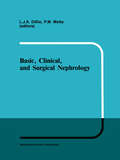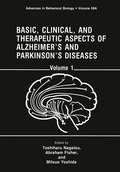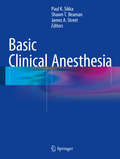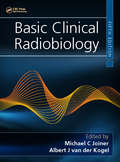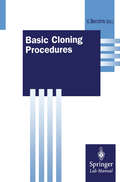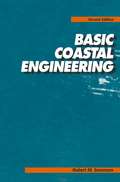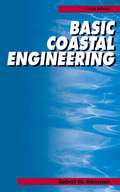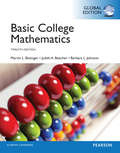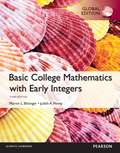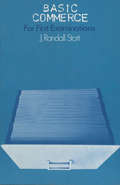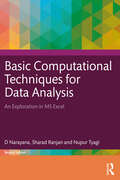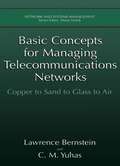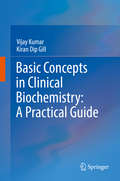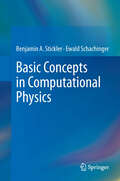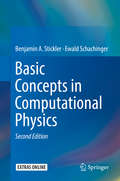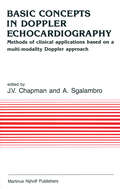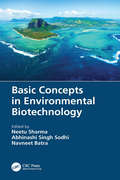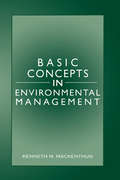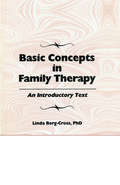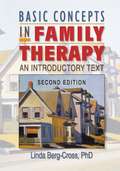- Table View
- List View
Basic, Clinical, and Surgical Nephrology (Developments in Nephrology #8)
by L. J. A. Didio P. M. MottaThis unique volume may very well foreshadow the treatment of renal disease in the twenty-first century. The editors have obviously compiled and reviewed the current clinical problems in which the kidney plays a major role. They then selected as topics for chapters those in which recent scientific investigations have added significant new data. The investigators themselves or their peers have been persuaded to produce a summary of current concepts of renal structure and function for each topic. The result is a volume which will be as invaluable as a clinical guide on the laboratory bench as it will be a reference for the clinician seeking guidance to rational therapy at the bedside. The strength of the volume lies in the incorporation of those data on renal cellular structure and function which hold the key to the etiology of the majority of renal diseases we now call 'end-stage'. Fully, two-thirds of the volume is devoted to current concepts of renal function and related subcellular structure of various renal tissues. The illustrations, correlations, and explanations are superbly presented in much detail and with an obvious effort to fill out the current knowledge of each subject. We may anticipate this book will remain a valuable reference for many years to come.
Basic, Clinical, and Therapeutic Aspects of Alzheimer’s and Parkinson’s Diseases: Volume 1 (Advances in Behavioral Biology #38A)
by Toshiharu Nagatsu Abraham Fisher Mitsuo YoshidaThis two-volume work contains the full text of the oral and poster presentations and the general discussion at the round table discussion of the Second International Conference on Alzheimer's and Parkinson's Diseases: Basic and Therapeutic Strategies, held at the Kyoto Park Hotel in Kyoto, Japan, on November 6-10, 1989. The First Conference was held at the Aviya Sonesta Hotel in Eilat, Israel, on March 24-27, 1985. The record of this First Conference was published by Plenum Press in 1986 as Volume 29 in Advances in Behavioral Biology, under the title "Alzheimer's and Parkinson's Diseases: Strategies for Research and Development." We are happy that the comprehensive texts of the oral and poster presentations of the Second Conference could again be published within the framework of this series. Since the First Conference in 1985, rapid progress has been made in both basic and 'therapeutic aspects of these diseases. About 700 scientists from allover the world participated in the Second Conference, and 300 papers were presented in oral and poster sessions. Many people and organizations have helped to organize this multi disciplinary international conference and hence have contributed to the scientific quality of these two volumes. We thank the members of the organizing committee, the organizations that provided financial support, and the contributing scientists for their enthusiastic participation. These two volumes follow the same publishing philosophy as the volume derived from the First Conference. They span a broad spectrum of topics and bridge preclinical and clinical concepts related to these diseases.
Basic Clinical Anesthesia
by Paul K. Sikka Shawn T. Beaman James A. StreetThis text presents the basic and clinical foundations of anesthesiology. It is easy to read and is comprehensive without being lengthy. Readers can test their knowledge with the “Clinical Review” questions at the end of chapters and will appreciate the abundance of color illustrations, clinical images, and practical tables. Chapters are highly organized and make liberal use of bulleted text where appropriate. Everything needed in a single source is here, from clinically important basic science to the full range of anesthetic practice: pain management and regional anesthesia, including ultrasound-guided peripheral nerve blocks; specialty anesthesia; preoperative evaluation and intraoperative management; ambulatory and non-operating room anesthesia; and critical care. The book also includes topical chapters on the obese patient, infectious diseases, alternative medicine, substance abuse, cosmetic surgery, robotic surgery, the hazards of working in the operating room, and residency requirements and guidelines.
Basic Clinical Radiobiology
by Michael C. Joiner Albert J. Van Der KogelBasic Clinical Radiobiology is a concise but comprehensive textbook setting out the essentials of the science and clinical application of radiobiology for those seeking accreditation in radiation oncology, clinical radiation physics, and radiation technology.Fully revised and updated to keep abreast of current developments in radiation biology and radiation oncology, this fifth edition continues to present in an interesting way the biological basis of radiation therapy, discussing the basic principles and significant developments that underlie the latest attempts to improve the radiotherapeutic management of cancer.This new edition is highly illustrated with attractive 2-colour presentation and now includes new chapters on stem cells, tissue response and the convergence of radiotherapy, radiobiology, and physics. It will be invaluable for FRCR (clinical oncology) and equivalent candidates, SpRs (and equivalent) in radiation oncology, practicing radiation oncologists and radiotherapists, as well as radiobiologists and radiotherapy physicists.
Basic Coastal Engineering
by Robert SorensenIn the 20 years since publication of the first edition of this book there have been a number of significant changes in the practice of coastal engineering. This new edition has been completely rewritten to reflect these changes as well as to make other improvements to the material presented in the original text. _ Basic Coastal Engineering is an introductory text on wave mechanics and coastal processes along with the fundamentals of the practice of coa~tal engi neering. This book was written for a senior or first postgraduate course in coastal engineering. It is also suitable for self study by anyone having a basic engineering or physical science background. The level of coverage does not require a math or fluid mechanics background beyond that presented in a typical undergraduate civil or mechanical engineering curriculum. The material presented in this text is based on the author's lecture notes from a one-semester course at Virginia Pol ytechnic Institute, Texas A&M University, and George Washington University, and a senior elective course at Lehigh University. The text contains examples to demonstrate the various analysis techniques that are presented and each chapter (except the first and last) has a collection of problems for the reader to solve that further demonstrate and expand upon the text material. Chapter 1 briefly describes the coastal environment and introduces the rela tively new field of coastal engineering.
Basic Coastal Engineering
by Robert M. SorensenThe second edition (1997) of this text was a completely rewritten version of the original text Basic Coastal Engineering published in 1978. This third edition makes several corrections, improvements and additions to the second edition. Basic Coastal Engineering is an introductory text on wave mechanics and coastal processes along with fundamentals that underline the practice of coastal engineering. This book was written for a senior or first postgraduate course in coastal engineering. It is also suitable for self study by anyone having a basic engineering or physical science background. The level of coverage does not require a math or fluid mechanics background beyond that presented in a typical undergraduate civil or mechanical engineering curriculum. The material p- sented in this text is based on the author’s lecture notes from a one-semester course at Virginia Polytechnic Institute, Texas A&M University, and George Washington University, and a senior elective course at Lehigh University. The text contains examples to demonstrate the various analysis techniques that are presented and each chapter (except the first and last) has a collection of problems for the reader to solve that further demonstrate and expand upon the text material. Chapter 1 briefly describes the coastal environment and introduces the re- tively new field of coastal engineering. Chapter 2 describes the two-dimensional characteristics of surface waves and presents the small-amplitude wave theory to support this description.
Basic College Mathematics, Global Edition
by Marvin L. BittingerObjective: Guided Learning The Bittinger Worktext Series recognizes that math hasn’t changed, but students—and the way they learn math—have. This latest edition continues the Bittinger tradition of objective-based, guided learning, while also integrating timely updates to the proven pedagogy. This edition has a greater emphasis on guided learning and helping students get the most out of all of the resources available, including new mobile learning resources, whether in a traditional lecture, hybrid, lab-based, or online course. The new edition supports students with quality applications and exercises, a new MyMathGuide workbook and video program, and an updated MyMathLab course that brings it all together! Teaching and Learning Experience This program will provide a better teaching and learning experience for you and your students. Here’s how: Improve Results: MyMathLab® delivers proven results in helping students succeed and provides engaging experiences that personalize learning. Guide Students’ Learning: The Bittinger team helps today’s math students stay on task by guiding them to understand what to do and when. Reinforce Study Skills: The Bittinger program is equipped with tools and resources to help students develop effective study and learning habits that will help them in their college careers and beyond
Basic College Maths with Early Integers, Global Edition
by Marvin L. Bittinger Judith A. PennaThe Bittinger Worktext Series recognizes that math hasn’t changed, but students–and the way they learn math–have. This latest edition continues the Bittinger tradition of objective-based, guided learning, while also integrating timely updates to the proven pedagogy. This edition has a greater emphasis on guided learning and helping students get the most out of all of the resources available, including new mobile learning resources, whether in a traditional lecture, hybrid, lab-based, or online course. Teaching and Learning Experience This program will provide a better teaching and learning experience for you and your students. Here’s how: Guide Students’ Learning: The Bittinger team helps today’s math students stay on task by guiding them to understand what to do and when. Reinforce Study Skills: The Bittinger program is equipped with tools and resources to help students develop effective study and learning habits that will help them in their college careers and beyond. MyMathLab not included. Students, if MyMathLab is a recommended/mandatory component of the course, please ask your instructor for the correct ISBN and course ID. MyMathLab should only be purchased when required by an instructor. Instructors, contact your Pearson representative for more information.MyMathLab is an online homework, tutorial, and assessment product designed to personalize learning and improve results. With a wide range of interactive, engaging, and assignable activities, students are encouraged to actively learn and retain tough course concepts.
Basic Computational Techniques for Data Analysis: An Exploration in MS Excel
by D Narayana Sharad Ranjan Nupur TyagiThis book is designed to equip students to navigate through MS Excel and basic data computation methods, which are essential tools in research or professional settings and in classrooms. It illustrates the concepts used in research and data analysis and economic and financial decision-making in business and in daily life. The book will help students acquire knowledge and develop skills in statistical techniques and financial analysis using MS Excel. With illustrations and examples, it will help the readers to: • Visualize, present, and analyze data through MS Excel spreadsheets and tables and create personal or business spreadsheets • Learn how to work with spreadsheets, use formulae, and perform calculations and analysis • Create tables including Pivot Tables • Become familiar with basic statistical and financial measures • Design creative spread sheets and communicate effectively in business using spreadsheets and data analysis This revised and updated second edition will be an essential resource for students of economics, commerce, management, and other social science subjects, and will be useful to those studying econometrics, financial technology, basic computational techniques, data analysis, and applied economics. Content The book is developed through three phases, with each phase standing on its own as well as providing a foundation for the next. In the first phase, Excel is introduced for the students to learn entry of data, manipulation of data, carrying out operations and develop presentations. The second phase introduces basic statistical measures of data summarisation and analysis, following which these are illustrated in Excel spreadsheets with the techniques introduced in the first phase. In addition, a few advanced tools of statistical analysis are introduced and illustrated in Excel. The third phase introduces financial measures of common use, their general computation and working them out in Excel. The book intends to illustrate the concepts used in economic and financial decision-making in business and in daily life; it helps demonstrate a deeper understanding from both theoretical and practical perspectives. An effort has been made to make the book student-friendly by using simple language and giving a number of illustrations in each chapter, solved in such a simple manner that they can be easily understood by the students. Practical questions have been included at the end of each chapter so that the students can independently solve them and test their understanding of the concepts and computations introduced in the chapter. Outcome At the end, students will be able to describe what a spreadsheet is and what Excel’s capabilities are and can work with elements that make up the structure of a worksheet. They will be able to work with spreadsheets and enter data in Excel, use formulae and calculations, and create tables, charts and pivot tables. They will be familiar with basic statistical and financial measures of general use. They will be able to do basic computations in statistics and finance in Excel. Students will acquire the capacity to create personal and/or business spreadsheets following current professional and/or industry standards. Their potential for critical thinking to design and create spreadsheets and communicate in a business setting using spreadsheet vocabulary will be enhanced. In the digital age, students necessarily need to know data, data sources and how to ‘dirty’ their hands with data. There can be no substitute to ‘talking through numbers’. The book introduces students to a variety of Indian and International data sources and teaches them how to import data-be it social, economic, financial and so on-to the Excel sheet. Once they master it, the data world is there for them to conquer! The educational background required for the student to understand the text is some basic English and Mathematics of school-leaving level. Some fl air for numbers will be an asse
Basic Computational Techniques for Data Analysis: An Exploration in MS Excel
by D Narayana Sharad Ranjan Nupur TyagiThis book is designed to equip students to navigate through MS Excel and basic data computation methods, which are essential tools in research or professional settings and in classrooms. It illustrates the concepts used in research and data analysis and economic and financial decision-making in business and in daily life. The book will help students acquire knowledge and develop skills in statistical techniques and financial analysis using MS Excel. With illustrations and examples, it will help the readers to: • Visualize, present, and analyze data through MS Excel spreadsheets and tables and create personal or business spreadsheets • Learn how to work with spreadsheets, use formulae, and perform calculations and analysis • Create tables including Pivot Tables • Become familiar with basic statistical and financial measures • Design creative spread sheets and communicate effectively in business using spreadsheets and data analysis This revised and updated second edition will be an essential resource for students of economics, commerce, management, and other social science subjects, and will be useful to those studying econometrics, financial technology, basic computational techniques, data analysis, and applied economics. Content The book is developed through three phases, with each phase standing on its own as well as providing a foundation for the next. In the first phase, Excel is introduced for the students to learn entry of data, manipulation of data, carrying out operations and develop presentations. The second phase introduces basic statistical measures of data summarisation and analysis, following which these are illustrated in Excel spreadsheets with the techniques introduced in the first phase. In addition, a few advanced tools of statistical analysis are introduced and illustrated in Excel. The third phase introduces financial measures of common use, their general computation and working them out in Excel. The book intends to illustrate the concepts used in economic and financial decision-making in business and in daily life; it helps demonstrate a deeper understanding from both theoretical and practical perspectives. An effort has been made to make the book student-friendly by using simple language and giving a number of illustrations in each chapter, solved in such a simple manner that they can be easily understood by the students. Practical questions have been included at the end of each chapter so that the students can independently solve them and test their understanding of the concepts and computations introduced in the chapter. Outcome At the end, students will be able to describe what a spreadsheet is and what Excel’s capabilities are and can work with elements that make up the structure of a worksheet. They will be able to work with spreadsheets and enter data in Excel, use formulae and calculations, and create tables, charts and pivot tables. They will be familiar with basic statistical and financial measures of general use. They will be able to do basic computations in statistics and finance in Excel. Students will acquire the capacity to create personal and/or business spreadsheets following current professional and/or industry standards. Their potential for critical thinking to design and create spreadsheets and communicate in a business setting using spreadsheet vocabulary will be enhanced. In the digital age, students necessarily need to know data, data sources and how to ‘dirty’ their hands with data. There can be no substitute to ‘talking through numbers’. The book introduces students to a variety of Indian and International data sources and teaches them how to import data-be it social, economic, financial and so on-to the Excel sheet. Once they master it, the data world is there for them to conquer! The educational background required for the student to understand the text is some basic English and Mathematics of school-leaving level. Some fl air for numbers will be an asse
Basic Concepts for Managing Telecommunications Networks: Copper to Sand to Glass to Air (Network and Systems Management)
by Lawrence Bernstein C.M. YuhasIt is important to understand what came before and how to meld new products with legacy systems. Network managers need to understand the context and origins of the systems they are using. Programmers need an understanding of the reasons behind the interfaces they must satisfy and the relationship of the software they build to the whole network. And finally, sales representatives need to see the context into which their products must fit.
Basic Concepts in Clinical Biochemistry: A Practical Guide
by Vijay Kumar Kiran Dip GillThis book is a practical guidebook in biochemistry, for medical as well as life sciences' students. The book covers reference values, sample collection procedure and detailed protocol to perform experiments. Each experiment starts with a brief introduction of the protocol, followed by specimen requirements and procedure. The procedures are presented in a very lucid manner and discuss details of calculations and clinical interpretations,The book is divided into 29 chapters, It offers references, general guidelines and abbreviations and provides principles and procedures of clinical biochemistry tests, along with their diagnostic importance.
Basic Concepts in Computational Physics
by Benjamin A. Stickler Ewald SchachingerWith the development of ever more powerful computers a new branch of physics and engineering evolved over the last few decades: Computer Simulation or Computational Physics. It serves two main purposes:- Solution of complex mathematical problems such as, differential equations, minimization/optimization, or high-dimensional sums/integrals.- Direct simulation of physical processes, as for instance, molecular dynamics or Monte-Carlo simulation of physical/chemical/technical processes.Consequently, the book is divided into two main parts: Deterministic methods and stochastic methods. Based on concrete problems, the first part discusses numerical differentiation and integration, and the treatment of ordinary differential equations. This is augmented by notes on the numerics of partial differential equations. The second part discusses the generation of random numbers, summarizes the basics of stochastics which is then followed by the introduction of various Monte-Carlo (MC) methods. Specific emphasis is on MARKOV chain MC algorithms. All this is again augmented by numerous applications from physics. The final two chapters on Data Analysis and Stochastic Optimization share the two main topics as a common denominator. The book offers a number of appendices to provide the reader with more detailed information on various topics discussed in the main part. Nevertheless, the reader should be familiar with the most important concepts of statistics and probability theory albeit two appendices have been dedicated to provide a rudimentary discussion.
Basic Concepts in Computational Physics
by Benjamin A. Stickler Ewald SchachingerThis new edition is a concise introduction to the basic methods of computational physics. Readers will discover the benefits of numerical methods for solving complex mathematical problems and for the direct simulation of physical processes. The book is divided into two main parts: Deterministic methods and stochastic methods in computational physics. Based on concrete problems, the first part discusses numerical differentiation and integration, as well as the treatment of ordinary differential equations. This is extended by a brief introduction to the numerics of partial differential equations. The second part deals with the generation of random numbers, summarizes the basics of stochastics, and subsequently introduces Monte-Carlo (MC) methods. Specific emphasis is on MARKOV chain MC algorithms. The final two chapters discuss data analysis and stochastic optimization. All this is again motivated and augmented by applications from physics. In addition, the book offers a number of appendices to provide the reader with information on topics not discussed in the main text. Numerous problems with worked-out solutions, chapter introductions and summaries, together with a clear and application-oriented style support the reader. Ready to use C++ codes are provided online.
Basic Concepts in Doppler Echocardiography: Methods of clinical applications based on a multi-modality Doppler approach (Developments in Cardiovascular Medicine #73)
by Lee S. CohenBasic Concepts in Doppler Echocardiography The objective of this textbook is to offer a detailed yet concise overview of the various applications of Doppler echocardiography. The fundamental principles of pulsed mode, continuous mode, and color flow mapping are fully explained as well as the clinical applications of each modality in the evaluation of various cardiac pathologies. A copious amount of figures and illustrations is included so that the reader is able to follow the discussions in the text by referring to the appropriate case studies. The emphasis of this book is focused upon the practical Doppler examination. The sections on theoretical considerations are therefore brief but comprehensive, while the didactic sections concentrate upon how to perform and interpret the clinical examination. The instrumentation of the Doppler system is also discussed so that the physician or technologist can acquire a basic understanding of how the Doppler system actually functions. CONTRmUTORS Bjorn AJ. Angelsen Dr. Tech. Professor of Biomedical Engineering University of Trondheim Trondheim , Norway Phillip Brun M. D. Director of Research Department of illtrasonology University Medical Center, Henri Mondor Paris , France Albert Meguira M. Sc. Biomedical Engineer Sonotron / Diasonics Paris , France and the Department of illtrasonology University Medical Center, Henri Mondor Paris , France Andreas Strauss M. D. Department of illtrasonology University Medical Center, Henri Mondor Paris France Sandra Yanushka B. Sc.
Basic Concepts in Environmental Biotechnology
by Neetu Sharma Abhinashi Singh Sodhi Navneet BatraThe book includes current and emerging concepts in the areas of environmental biotechnology such as pollution sources, control and measurement, solid waste management, bioremediation, biofuels, biosensors, bioleaching, conservation biotechnology and more. The book also includes recent innovations made in this field and incorporates case studies to help in understanding the concepts. This book applies principles from multidisciplinary sciences of environmental engineering, metabolic engineering, rDNA technology and omics to study the role of microbes and plants in tackling environmental issues. It also includes content related to risk assessment and environmental management systems. Each chapter provides problems and solutions of different topics with diagrammatic illustrations and tables for students, researchers and other professionals in environmental biotechnology. Explores cutting-edge technologies, including nanotechnology-based bioremediation, value-added products from waste and emerging techniques related to environmental risk assessment and monitoring Reviews the current methods being applied in the environment field for pollution control, waste management, biodegradation of organic and inorganic pollutants and so on Provides in-depth knowledge of the latest advancements in the field of environmental biotechnology such as bioleaching, biomining and advances in biotechnology-based conservation of biodiversity Introduces undergraduate and post-graduate students to basic concepts of environmental biotechnology and allied fields Discusses different products such as biofuels, biopolymers and biosensors that are being produced using biotechnological methods, thus contributing towards the goal of sustainable development Dr. Neetu Sharma is Assistant Professor in the Department of Biotechnology, GGDSD College, Chandigarh, India. The main thrust of her research centers on biotechnology, bioremediation and nanotechnology. Abhinashi Singh Sodhi is Assistant Professor in the Department of Biotechnology, GGDSD College, Chandigarh, India. His current research focuses on waste reduction, valorization and bioproduct formation. Dr. Navneet Batra is Associate Professor and Head, Department of Biotechnology, GGDSD College, Chandigarh, India. He has extensive academic and research experience of over 20 years with specialization in biotechnology and biochemical engineering.
Basic Concepts in Environmental Biotechnology
by Neetu Sharma Abhinashi Singh Sodhi Navneet BatraThe book includes current and emerging concepts in the areas of environmental biotechnology such as pollution sources, control and measurement, solid waste management, bioremediation, biofuels, biosensors, bioleaching, conservation biotechnology and more. The book also includes recent innovations made in this field and incorporates case studies to help in understanding the concepts. This book applies principles from multidisciplinary sciences of environmental engineering, metabolic engineering, rDNA technology and omics to study the role of microbes and plants in tackling environmental issues. It also includes content related to risk assessment and environmental management systems. Each chapter provides problems and solutions of different topics with diagrammatic illustrations and tables for students, researchers and other professionals in environmental biotechnology. Explores cutting-edge technologies, including nanotechnology-based bioremediation, value-added products from waste and emerging techniques related to environmental risk assessment and monitoring Reviews the current methods being applied in the environment field for pollution control, waste management, biodegradation of organic and inorganic pollutants and so on Provides in-depth knowledge of the latest advancements in the field of environmental biotechnology such as bioleaching, biomining and advances in biotechnology-based conservation of biodiversity Introduces undergraduate and post-graduate students to basic concepts of environmental biotechnology and allied fields Discusses different products such as biofuels, biopolymers and biosensors that are being produced using biotechnological methods, thus contributing towards the goal of sustainable development Dr. Neetu Sharma is Assistant Professor in the Department of Biotechnology, GGDSD College, Chandigarh, India. The main thrust of her research centers on biotechnology, bioremediation and nanotechnology. Abhinashi Singh Sodhi is Assistant Professor in the Department of Biotechnology, GGDSD College, Chandigarh, India. His current research focuses on waste reduction, valorization and bioproduct formation. Dr. Navneet Batra is Associate Professor and Head, Department of Biotechnology, GGDSD College, Chandigarh, India. He has extensive academic and research experience of over 20 years with specialization in biotechnology and biochemical engineering.
Basic Concepts in Environmental Management
by Kenneth M. MackenthunEnvironmental professionals are (and will continue to be) under increased pressure to become more knowledgeable of environmental management issues.Basic Concepts in Environmental Management fulfills the long-standing need for fundamental knowledge-especially concerning government regulations on environmental and natural resource protection.As a leading environmental professional and consultant since the 1940s, Kenneth M. Mackenthun offers a unique perspective on the breadth, scope, and ever-constant change in environmental legislation at the federal, state, and local levels... and what those guidelines signify for industry and citizens alike.By maintaining an awareness of existing and forthcoming laws, environmentalists can substantially enhance their career potential-and be in a better position to protect the land, air, and sea. The starting point for that knowledge: Basic Concepts in Environmental Management.
Basic Concepts in Environmental Management
by Kenneth M. MackenthunEnvironmental professionals are (and will continue to be) under increased pressure to become more knowledgeable of environmental management issues.Basic Concepts in Environmental Management fulfills the long-standing need for fundamental knowledge-especially concerning government regulations on environmental and natural resource protection.As a leading environmental professional and consultant since the 1940s, Kenneth M. Mackenthun offers a unique perspective on the breadth, scope, and ever-constant change in environmental legislation at the federal, state, and local levels... and what those guidelines signify for industry and citizens alike.By maintaining an awareness of existing and forthcoming laws, environmentalists can substantially enhance their career potential-and be in a better position to protect the land, air, and sea. The starting point for that knowledge: Basic Concepts in Environmental Management.
Basic Concepts In Fa: An Introductory Text
by Linda Berg CrossFirst published in 1987. Routledge is an imprint of Taylor & Francis, an informa company.
Basic Concepts In Fa
by Linda Berg CrossFirst published in 1987. Routledge is an imprint of Taylor & Francis, an informa company.
Basic Concepts in Family Therapy: An Introductory Text, Second Edition
by Linda Berg CrossGain confidence and creativity in your family therapy interventions with new, up-to-date research!Basic Concepts in Family Therapy: An Introductory Text, Second Edition, presents twenty-two basic psychological concepts that therapists may use to understand clients and provide successful services to them. Each chapter focuses on a single concept using material from family therapy literature, basic psychological and clinical research studies, and cross-cultural research studies. Basic Concepts in Family Therapy is particularly useful to therapists working in a family context with child- or adolescent-referred problems, and for students and clinicians treating the problems they see every day in their community. The book builds on the strengths of the first edition, incorporating ideas and articles that have become worthy of investigating since 1990 into the original text. This new edition also introduces five new chapters on resiliency and poverty, adoption, chronic illness, spirituality and religion, and parenting strategies. The new chapters make the book far more relevant for students and clinicians try ing to use family theory and technique in response to the problems they see in their communities. Basic Concepts in Family Therapy will assist you in offering clients better services by providing a deeper understanding of the contemporary family in its various forms, the psychological bonds that shape all families, and the developmental stages of the family life cycle. This exploration of how family demography, stages and life cycles affect family functions is a solid foundation from which all of the therapeutic concepts in this book can be explored. Some of the facets of family therapy you will explore in Basic Concepts in Family Therapy are: the importance of spirituality and religion in family therapy generational boundaries, closeness, and role behaviors managing a family's emotions defining problems and generating and evaluating possible solutions teaching children specific attitudes, values, social skills, and norms transracial adoptions and normative processes and developmental issues of adoptive parents strategies for reducing conflict . . . and much more!Basic Concepts in Family Therapy will help to broaden your understanding of the ways families function in general. You can use the effective concepts explored in this text to make a thorough assessment of the impact of a disorder on a child and on the rest of his or her family, as well as how family dynamics might have shaped or exacerbated the problems. The concepts described in this text can be customized to clients’cultural values to avoid unnecessary resistance. As a new therapist, you will gain confidence in your assessments, and if you are already a seasoned professional, you will gain creativity in your interventions.
Basic Concepts in Family Therapy: An Introductory Text, Second Edition
by Linda Berg CrossGain confidence and creativity in your family therapy interventions with new, up-to-date research!Basic Concepts in Family Therapy: An Introductory Text, Second Edition, presents twenty-two basic psychological concepts that therapists may use to understand clients and provide successful services to them. Each chapter focuses on a single concept using material from family therapy literature, basic psychological and clinical research studies, and cross-cultural research studies. Basic Concepts in Family Therapy is particularly useful to therapists working in a family context with child- or adolescent-referred problems, and for students and clinicians treating the problems they see every day in their community. The book builds on the strengths of the first edition, incorporating ideas and articles that have become worthy of investigating since 1990 into the original text. This new edition also introduces five new chapters on resiliency and poverty, adoption, chronic illness, spirituality and religion, and parenting strategies. The new chapters make the book far more relevant for students and clinicians try ing to use family theory and technique in response to the problems they see in their communities. Basic Concepts in Family Therapy will assist you in offering clients better services by providing a deeper understanding of the contemporary family in its various forms, the psychological bonds that shape all families, and the developmental stages of the family life cycle. This exploration of how family demography, stages and life cycles affect family functions is a solid foundation from which all of the therapeutic concepts in this book can be explored. Some of the facets of family therapy you will explore in Basic Concepts in Family Therapy are: the importance of spirituality and religion in family therapy generational boundaries, closeness, and role behaviors managing a family's emotions defining problems and generating and evaluating possible solutions teaching children specific attitudes, values, social skills, and norms transracial adoptions and normative processes and developmental issues of adoptive parents strategies for reducing conflict . . . and much more!Basic Concepts in Family Therapy will help to broaden your understanding of the ways families function in general. You can use the effective concepts explored in this text to make a thorough assessment of the impact of a disorder on a child and on the rest of his or her family, as well as how family dynamics might have shaped or exacerbated the problems. The concepts described in this text can be customized to clients’cultural values to avoid unnecessary resistance. As a new therapist, you will gain confidence in your assessments, and if you are already a seasoned professional, you will gain creativity in your interventions.
